Electrodes Placed in Brain May Offer Way of ‘Sensing’ Parkinson’s Arrival

Engineers with Michigan State University (MSU) are developing diamond-based electrodes that might detect early warning signs of neurodegenerative diseases such as Parkinson’s in a living brain.
MSU researchers Wen Li and Erin Purcell have received $3.4 million in funding from the National Institutes of Health and an MSU Strategic Partnership Grant to conduct preclinical work evaluating the safety, durability, and performance of the diamond-based electrodes implanted in rodents’ brain tissue.
These electrodes will allow researchers to monitor the brain’s biochemistry on a live feed. Specifically, they will look at levels of dopamine, a neurotransmitter (or chemical messenger) that neurons use to communicate, which decline over time in people with Parkinson’s.
“By the time patients with Parkinson’s disease start noticing problems with their motor systems, they may have already lost 60 to 70 percent of their normal dopamine levels,” Purcell, an associate professor at MSU, said in a press release. “This is an untapped window of opportunity. If you can detect that loss earlier then you open up opportunities to treat the disease earlier.”
“Our areas of expertise are complementary,” added Li, an associate professor in the Department of Electrical and Computer Engineering, while Purcell works both in that department and the university’s Department of Biomedical Engineering.
Li’s team specializes in new devices, and Purcell’s focuses on the application of these devices to biological problems.
Scientists will monitor feeds from the diamond-based electrodes implanted in the animals’ brains for up to six months, looking for evidence in living tissue of changes in dopamine levels that might signal Parkinson’s onset in a rodent model of the disease.
Living brain tissue contains a mix of chemical, and whether this sensor can detect with sufficient accuracy and sensitivity changes in dopamine levels is far from assured, Purcell said.
“There are a lot of challenges,” she said. “We have to see if diamond can overcome those.”
These two teams will make use of the resources and experts at the Fraunhofer USA Center for Coatings and Diamond Technologies for its diamond-based approach.
“Diamond is a very unique material that has the potential to improve the stability of our devices,” Li said.
Because diamond is an extremely hard mineral, researchers hope that it sustains six months as an implant without degrading or decomposing over time. Its strength, however, can also be a vulnerability, since implants need to have some degree of flexibility so that they do not damage soft tissues.
These researchers are also using this grant money to make smaller versions of their electrodes, aware that “when the dimensions shrink, the device becomes more compliant” or flexible, Li added.
If the team succeeds, its device may offer a way of spotting signs of Parkinson’s well before this disease is evident and damage is done.
“Think of it as a sort of stealthy sensor inside the brain,” Purcell said.






